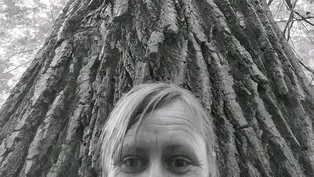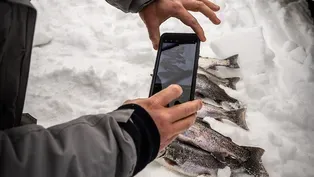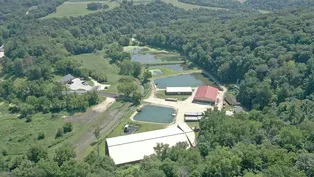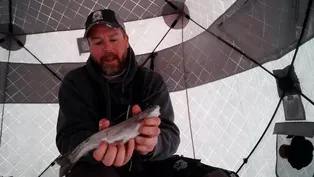Prairie Sportsman
Coldwater Trout
Season 14 Episode 2 | 27m 46sVideo has Closed Captions
Host Bret Amundson goes ice fishing for rainbow trout and visits two trout hatcheries.
Host Bret Amundson goes ice fishing for rainbow trout and visits two southeast Minnesota trout hatcheries.
Problems with Closed Captions? Closed Captioning Feedback
Problems with Closed Captions? Closed Captioning Feedback
Prairie Sportsman is a local public television program presented by Pioneer PBS
Production sponsorship is provided by funding from the Environment and Natural Resources Trust Fund, West Central Initiative, Shalom Hill Farm, and members of Pioneer PBS.
Prairie Sportsman
Coldwater Trout
Season 14 Episode 2 | 27m 46sVideo has Closed Captions
Host Bret Amundson goes ice fishing for rainbow trout and visits two southeast Minnesota trout hatcheries.
Problems with Closed Captions? Closed Captioning Feedback
How to Watch Prairie Sportsman
Prairie Sportsman is available to stream on pbs.org and the free PBS App, available on iPhone, Apple TV, Android TV, Android smartphones, Amazon Fire TV, Amazon Fire Tablet, Roku, Samsung Smart TV, and Vizio.
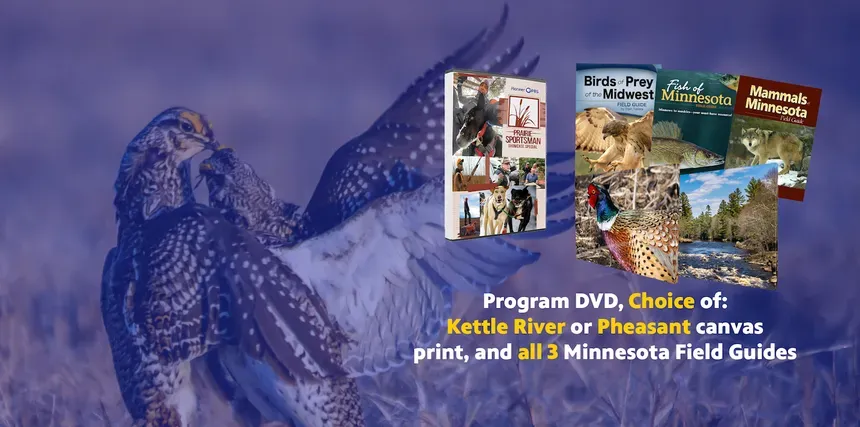
Prairie Sportsman Premium Gifts
Do you love the great outdoors, hunting, fishing, hiking and conservation? Consider becoming a friend of Prairie Sportsman to support the show and receive gifts with your contribution.Providing Support for PBS.org
Learn Moreabout PBS online sponsorship(upbeat music) - Join us on the next Prairie Sportsman as we cut some holes and go sight fishing for rainbow trout with Garett Svir from Slab Seeker Fishing.
We'll also visit the Minnesota DNR Southeast Trout Fisheries and see how they use natural cold water springs to sustain their hatcheries and protect Minnesota's trout population.
And we'll join Nicole Zempel for a fast forage.
Welcome to Prairie Sportsman.
I'm Bret Amundson.
We got a great show for you this week and it starts right now.
(whimsical music) - [Announcer] Funding for Prairie Sportsman is provided by the Minnesota Environment and Natural Resources Trust Fund, as recommended by the Legislative Citizen Commission on Minnesota Resources, and by Mark and Margaret Yackel-Juleen on behalf of Shalom Hill Farm, a retreat and conference center in a prairie setting near Wyndham, Minnesota, on the web at shalomhillfarm.org, and by Live Wide Open, and Western Minnesota Prairie Waters.
(dramatic music) - [Bret] He's back.
He's got it in his mouth right now.
There you go.
Nice, nice.
(laughs) Sight fishing rainbow trout.
- [Garett] It doesn't get any better, buddy.
(whimsical music) - [Bret] Winter in Minnesota.
It's easy for people to cozy up to a fire or maybe move down south for a few months.
But for the throng of anglers who wait for lakes to freeze up each year, this is paradise.
Today we're out with Garett Svir from Slab Seeker Fishing to target rainbow and brown trout.
And we're gonna do it in a way that it's arguably the most exciting method possible.
Lens is a little fogged up, but we just got in here, just got set up and you were marking fish immediately, Garett.
- Right away I dropped down there, and I had one.
He didn't hit it, he kept bumping it with his head.
And so I never seen the wax worm disappear.
I can just barely make out my jig.
Well, that's a good sign, there's a few around today.
- [Bret] While we will be using electronics, Garett augered out holes big enough for us to look through that clear water to see a fish down there chasing our bait around.
- [Bret] How deep are we?
- [Garett] We are set up in 10 feet of water here, and we're fishing about halfway down the water column.
And that seems to be kind of the deal there, about halfway down, you get their attention from out in that deeper water.
We're set up on a main lake point here where it drops real steep, so we're in 10 feet.
But if you were to take a step out the door, you'd be in 20 out there.
It's really on a steep break line, which seems to be my most high percentage spots on these trout lakes.
- When you told me about sight fishing for these fish, like I was envisioning a big spear hole basically, a big rectangle that we're gonna be looking down, but that's not what we got here.
- You know what, we have and we can do that too.
I had a guy that was helping me for a while a few years back and we were every morning doing an ice off, drilling four holes and then connecting them, and then spinning the big chunk of ice underneath.
I went back to grab customers at the truck and he fell in trying to spin that.
(laughs) - Oh no.
- So I came back to him in the hole holding onto the edge and so that kind of freaked me out.
So I haven't been doing the spear hole as much in the morning just because of wrestling that big ice block.
But yeah, we definitely do that, it works great too.
I've been kind of clover leafing these.
I think I drilled four for you.
- We're kind of employing a one-two punch here.
I've got this bigger spoon on, and you just have a small tungsten on?
- [Garett] Yeah, just a little tungsten jig with a wax worm.
- So a lot of times you can call 'em in with one of 'em, with a bigger spoon and then the smaller tungsten will catch these fish, and that's common with a lot of species, I think.
But depending on how aggressive the bite is, will determine which one of those two presentations they end up going after.
- [Garett] Exactly.
- Oh, I just missed one.
Just had one come and miss it, there he is.
Got him.
- [Garett] Nice.
- (laughs) So this fish, there he is, right here.
Oh, it's a pike.
- [Garett] Oh it's a pike.
(Bret and Garett laugh) - That's funny, a little pike.
So I just saw the flash and that's the beauty of sight fishing, as he came in and and missed it, and I saw the flash, and I got excited so I jigged it a little more, and he came in and and smashed it.
Yeah, not the target species, but you know what?
Catching fish is catching fish, and seeing them is even that much more fun, so... - Absolutely.
Yeah, unfortunately we do get a few-oh here's a big trout, Big trout down there.
Come on, come on.
Oh, he is losing interest.
- I have such a hard time with that.
I know I've got a couple of buddies that they won't fish with anything but a tungsten, at least for primarily panfish, bluegills.
- [Garett] Sure.
- Perch, whatever, but I'm a spoon guy, man.
I love something big and noisy and flashy down there.
A lot of times I get out-fished.
(Garett and Brad laugh) - [Garett] You know with these though, they're charged up, that's a pretty good plan.
I mean they're pretty aggressive fish.
- I think that's my biggest problem though is I like to fish, you know?
Even up on a place like Lake of the Woods, where deadsticks are so effective or walleye fishing when that real subtle small light presentation does so well.
I hate it, I want to jig.
- [Garett] You wanna be jigging.
Yeah, me too.
- That's what happens when there's a lot going on and all of a sudden I saw a mark drill high and before I could even get the camera going, he came up and smoked it and I knew I was gonna drop him.
(Garett laughs) And... - [Garett] We got him.
(laughs) - We got him.
- [Garett] (laughs) There you go.
- Nice catch.
So he's not a giant but this is a stocked lake, so it's put and take, really, so they encourage harvest of these fish.
You can keep five of 'em in Minnesota and... - [Garett] Great on the smoker, really good on the grill, you can pan fry 'em.
- So we'll give you a better look at 'em there if we can focus.
Nice.
Here's our first one, Garett.
- [Garett] Dinner fish, buddy.
- Hell yeah.
Throw this guy back here, just put him anywhere.
- [Garett] They're not easy to hold is one thing.
- That's what I love about 'em though.
- [Garett] (laughs) I know.
- That's what makes 'em so much fun to catch 'cause when you realize when you hold one, just how strong they are, when they squirm back and forth like that, that's what they're doing down there when they hook up with you.
- Exactly.
The best way to line 'em, you did that perfect, is instead of trying to grab 'em when they're thrashing in the hole, is just to slide 'em up on the ice and then grab 'em because it seems like you can never get ahold of 'em in the hole like that.
Oh I got one down here.
- [Bret] Yeah, see I just marked one again.
I was gonna show you what I was using but then I marked the fish.
- (laughs) And they usually do come in little packs like that too, there'll be little groups of- - Oh yeah, I got one on me right now.
- [Garett] Oh there he is, he's chasing it, huh?
Can't see him on your Vexilar.
- It's so much fun to be able to watch them down there and sight fish these trout, Garett, oh you just missed it again.
(laughs) - [Garett] I had 'em too, here he is.
- Yeah I think I lost him.
- I got 'em on here.
This is a better one here, not a huge but better.
- [Bret] Oh yeah.
- Just kamikazes, aren't they?
Isn't that fun?
- [Bret] So much fun.
- They're the best in here just to kind of slide 'em up on the ice here next to you and that way you don't, if I try to grab 'em on the wall, I lose 100% of these fish.
(Bret and Garett laugh) There he is.
- [Bret] I'll tell you that's what I kind of like about these fish is when they're aggressive, they hit on just about everything.
Nice fish right there, Garett, and then... - Well I'm glad I got one.
You were kind of putting the screws to me at first this morning.
(laughs) - [Bret] Let's show people what you're using there.
- [Garett] I Just have this little tungsten jig on.
We're trying to do kind of a one-two punch so it's just a little tungsten fly with a little hair in the back.
Then I'm tipping that with a wax worm, and I told Brett we needed small, and he said this spoon catches everything.
(Bret laughs) He was right.
He's seen 10 times more fish than I have this morning with that spoon.
- [Bret] I'll tell you what, this Al's Goldfish.
Am I getting a focus on it?
I can't, yeah, there we go.
It's got this bent shape to it and this big shiny gold color to it, and I didn't know much about Al's Goldfish Lure Company, and then I got introduced to him up at Lake of the Woods, and we put on this Forty Niner and it caught all our fish.
I tried a couple of different lures right away, Garett, once I switched to this one, I didn't take it off the entire day we were fishing.
- The rest of the day?
Everybody else I was catching fish all caught it on it.
So company's been around for 70 years, - [Garett] Has it really?
- They're from out east and they actually make lures that are coated in 22 karat gold.
- [Garett] Wow!
- This one's not, this is just a gold color, but if it catches fish, I don't care what it's coated in.
- [Garett] (laughs) Right, exactly.
(dramatic music) - [Bret] He's on it, oh, he's right on it.
You got him, you got him.
(laughs) All right.
Nice.
- [Garett] (grunts) You know I dropped down to the bottom where you said the fish were.
(Garett and Bret laugh) You're fighting him with the spoon for me and then I just got in the zone and he came over and ate it.
(upbeat music) - I feel like anytime I fish with an underwater camera or sight fish like we are today, my life changes (laughs) because you get a glimpse of what you're actually doing down there.
You can see your action of your jig or lure or spoon, whatever you are using, and if you're lucky, you can see how the fish react to it.
And sometimes it's good to see what you're doing down there and react and sometimes it's better just to not pay attention.
- I was just responding to a text there, and I got a fish and what that tells us, even when you think you're not learning anything, you're learning something.
So when I'm looking down the hole, I'm probably over jigging it today.
Because as soon as I stop to answer a text message, I got bit in like three seconds.
That's why if you're ever in a guide trip with me, and you see me texting, I'm just trying to learn (Bret and Garett laugh) what the fish are wanting.
- [Bret] When it comes to trout fishing in Minnesota, make sure you pay attention to the regs because there's different rules and season dates in different areas of the state.
- [Garett] Keep five of these, but only three of the five can be over 16 inches.
So I was just telling Bret we got four, but we need to get some of these overs.
I'd like him to at least see a couple of the bigger ones.
- [Bret] Yeah, for sure.
- [Garett] Actually I have seen a couple of the bigger ones.
I had one on briefly but ah... - [Bret] You had one job, Garett.
So we're looking at the backside of winter here, backside of ice fishing, and we're seeing plenty of fish.
- I know and I always hear when you go down towards the metro and a lot of those lakes, they get fished out right after winter trout opener.
So, and I always hear about a lot of those metro lakes.
After the first week, you might as well not even bothered.
I haven't fished down there, but it's always kind of a surprise to me because you know here in central Minnesota, the few lakes that we have here for trout, they produce fish throughout the whole season.
I mean, a lot of times towards the end of March, fishing get really super good for 'em, almost the best bite of the whole winter.
- [Bret] Seeing under the ice is like seeing into a different world.
And seeing how fish are actually reacting to what you're doing is just gonna make you a better angler and you're gonna have a lot more fun.
And trout are the perfect species for sight fishing because of their aggressive nature.
(dramatic music) - [Garett] He's back, he's back, he's on it.
- [Bret] You see him?
Oh, he had it in his mouth.
He's back, he's got it in his mouth right now.
There you go.
Nice!
(laughs) Sight fishing rainbow trout.
- [Garett] It doesn't get any better buddy.
(fishing reel spins) (water splashes) - [Bret] Heck yeah.
- [Garett] (laughs) Beautiful.
- [Bret] That's pretty cool.
- Love it man.
- So that fish came in, and we just had a deadstick down while I was filming and I was watching it and I had the camera right on it 'cause I wanted to film... - [Garett] Our perspective.
- Yeah, sight fishin' these rainbows, I wanted to get it with the camera so all of a sudden I saw this rainbow come in, I hit the record button, he ate it, spit it out, came back, ate it, spit it out, and then I realized I wasn't recording it either.
(Garett laughs) So I'm like, Garett, get over here, grab this rod, if he comes back, you're gonna set the hook on this fish.
He came back, and we got the whole thing.
So there is your sight fishing for rainbow trout experience.
What do you call it?
Bowl fishing of ice fishing?
- Yeah, it's like the bow hunting of ice fishing.
You gotta get that close to 'em.
- [Bret] Well, nice job buddy.
- Thanks, man that was awesome.
(upbeat music) (jaunty music) - [Bret] Approximately 5,000 gallons per minute run from these springs year round.
The cold clean water flows through raceways for rainbow trout broodstock, raised to three years old.
- [Nicole] That contains a chemical compound that's actually used in our aspirin.
(whimsical music) - [Bret] Minnesota trout thrive in deep cold-water lakes in the north, (water rushes) and in clear spring-fed streams in the southeast where groundwater flows through porous limestone.
The Minnesota DNR raises trout in those cold clean waters.
(light airy music) - [Shawn] We have four cold water hatcheries in Minnesota.
One is near Emily, Minnesota, that's Spire Valley Hatchery.
We have three down the southeast down here.
It's the Peterson State Fish Hatchery, the Lanesboro Hatchery, and the Crystal Springs Hatchery.
We each produce a little bit different species of fish or different strains of fish of trout, but each have about 48 degree water, so perfect for rearing trout.
- [Bret] The Peterson Hatchery produces about 40,000 lake trout and 100,000 splake annually for northern Minnesota.
- These lake trout are more of a cold deep water lake or lake fish, so they like a little depth and dark and cold.
The splake trout is a combination hybrid of a lake trout and a brook trout.
The Minnesota biologists can use that as a tool in different locations, different habitats.
We stock lakes around the Hinckley area, Brainerd area, Grand Rapids, International Falls, and Grand Morey.
(dramatic music) When the ice comes off a lake, you've got a certain amount of time 'til some of those lakes that we're stocking into, the surface temperatures are gonna be up in the 70s and when we have 48 degree water all year round, we gotta try to get it up there early spring when the water's about 48 degrees on top of the water when the ice goes off and then those fish can get down to the colder water down below before it heats up on top.
- [Bret] The Peterson Hatchery has also started raising a native brook trout strain called Minnesota Driftless, a heritage trout.
- The DNR did some genetic testing and determined that this strain is historically true to Minnesota.
We've determined what streams have that genetics, and we've gone in every year for the past three years now to get the gametes or the eggs and produce our own broodstock.
Although we'll go mainly in the southeast rivers, Southeast Minnesota rivers.
(somber music) (fishing reel creaking) - [Bret] Once abundant in southeast Minnesota, brook trout populations plummeted during settlement times when hillsides were logged for row crop production and cattle grazing.
(animal moos) Streams filled in with sediment and became wider, shallower, warmer and not favorable to brook trout.
Brown trout brought in from Germany fared better.
- The brown trout can live a little bit more in harsh conditions, warmer waters, bigger waters.
The brook trout like a little more clear and cold.
- [Bret] While native brook trout populations are coming back, browns are still raised for streams where they adapt better than brookies, and for put and take fisheries such as southwest Minnesota streams, where large fish are stocked for spring fishing.
The state fish hatchery in Lanesboro raises about 370,000 brown trout annually as well as 300,000 rainbows.
(cheerful slow music) - Fish get stocked all throughout the state of Minnesota.
Oftentimes we stocked fish to create a fishery for, you know, a certain season like in the springtime, or winter fisheries have become a very popular option.
We know they won't reproduce and proliferate in those areas, but it creates a fishery for a period of time that seems to be very popular.
A lot of the brown trout we stock here actually gets stocked in streams in the southeast as fingerlings.
Most of the yearling rainbow trout we produce, the catchable-size rainbow trout we produce gets stocked in lakes throughout the state.
There's a lot of natural reproduction of brown trout in streams in the southeast.
We don't know of any natural reproducing rainbow trout in southeast Minnesota and so that's why we produce all the rainbow trout in a hatchery and stock goes out as catchable-size fish.
(lively music) - [Announcer] Welcome to the Lanesboro State Fish Hatchery.
This hatchery has been a part of the southern Minnesota landscape for over 70 years.
Before becoming a hatchery, this land was used as a gristmill.
The spring that... - [Bret] Land for the Lanesboro Hatchery was purchased by the state in 1926 and expanded over the years.
A major renovation of Minnesota's largest cold water hatchery was completed in 2021.
- The old hatchery, the infrastructure was failing, the beams, the frame, the beams were rusting all the way through, and it was in danger of collapsing.
Also, there needed to be improvements to the water quality going into the nursery.
One of the most important parts of the new hatchery construction was the degassing tower.
The degassing was needed to remove dissolved radon and nitrogen and add back oxygen to improve the water quality for the incubating eggs and the first life stages of the fish.
(water rushes) This is one of two springs that are in the area that feed springwater to the hatchery.
(lively music) - [Bret] Approximately 5,000 gallons per minute run from these springs year round.
The cold clean water flows through raceways for rainbow trout broodstock, raised to three years old.
The adults will then spawn about a million eggs before retiring to Minnesota lakes.
Fertilized eggs are disinfected and transferred into an incubation room.
- Each lot of eggs comes in once a week and then that incubates for about a month before it gets transferred out.
The two species spawn at different times which works out really well for our operation.
Brown trout starts spawning in September.
Rainbow trout starts spawning in October.
Nursery area is where the eggs actually hatch.
They stay in there until they're on feed and they grow in there for a period of time 'til they outgrow those tanks.
Fish get transferred out of the nursery in about April when they move outside.
This is one of our fingerling production ponds that have about 260,000 rainbow trout growing in it.
So this pond will get stocked with fingerlings in the summer about mid-July and then gets harvested in the springtime April and May.
(lively music) (slow upbeat music) - [Bret] In the wild, brown trout like to hide in shade or under rocks, so those fingerlings are raised in closed buildings.
- They're about eight months old or so, around three or four inches long.
The rainbows are a lot easier to raise in a hatchery setting than browns are.
They take well to being handled and being combined in a raceway and also being fed a prepared feed.
Harvesting ponds happens in the springtime when ice is melting and lakes are opening up and then they'll be transferred to staging raceways before they get loaded on trucks and distributed throughout the state.
This building is where we load most of our fish out of onto our big transport trucks which deliver fish throughout the state.
They go to southwest Minnesota, Redwood River, and they go up to Grand Morey, Grand Rapids, Bemidji, all over and then they get distributed in smaller trucks from there.
(slow upbeat music) - You know we're rearing quality fish and also providing 'em to the recreational user, you know, the public and especially the kids.
It's fun to have the kids get into fishing and be able to catch fish.
You get a rod in your hand and they catch a trout.
Yeah, I think they fight pretty good.
If you get kids in at the young age, you know, they're gonna be a lifetime fisherman.
- [Scott] Trout hatcheries are important to Minnesotans because they help to create new fisheries.
They help to enhance existing fisheries and create artificial fisheries where there wouldn't be any opportunity for fishing.
(light upbeat music) (jaunty music) (lively music) - I'm really excited today to be beside this lovely cottonwood tree along the Minnesota River.
People might not realize that cottonwood trees get a very bad rap.
If you've ever talked about, you know, the little fluffy snowy-like cotton that flies around in the air in July, or if people have pools, and they kind of land in a person's pool, or because it's a poplar, their branches break off easily, and people might get some of the sticky cottonwood bud film on their vehicle windshields.
So all of these things add up to, I think, the cottonwood tree being so undervalued and underappreciated.
It's a pretty marvelous tree and I'll tell you why.
The entire tree is medicinal and it's edible and oftentimes people would not look at these buds and think that it would be something that you could eat.
That contains a chemical compound that's actually used in our aspirin, proven anti-inflammatory properties, antimicrobial, antibacterial.
(upbeat music) The best time to harvest cottonwood buds is actually during the cooler weather because you don't get the stickiness all over you.
I never take the buds directly from the tree.
As I mentioned, it is a poplar tree, branches fall all the time, and usually after a good wind or a storm, you walk around any cottonwood tree and you're gonna see what I call medicine drops all around on the ground.
So no need to take them off the tree.
They're right there on the ground for the picking.
And when you're looking there, at which ones to pick, you do want them to be firm to the touch, and preferably still kind of a greenish shade.
You can harvest them when they're darker than that.
In the winter times you'll see that often, and that's fine too.
But this, what I'm holding right here is kind of like primo.
These are really good buds.
So what I am gonna do to make the balm or salve is I will go home and I will just simply pluck the buds right from the little branch.
I fill a mason jar halfway full with the buds, then I top the mason jar off with the extra virgin olive oil, and I let them soak between six and 12 months.
At that time, you can then strain that out, and then you can add beeswax on a double boiler to the thickness that you'd like, and boom, you have a cottonwood bud salve or balm, and that is excellent for achy joints, sore muscles, eczema, any variety of skin conditions, the stuff works wonders on it.
Also, if you're not feeling well, to kind of rub it on your chest.
It's an expectorant as well.
So really it's kind of a miracle in a jar and it all comes from the cottonwood tree and their buds.
(light whimsical music) - [Announcer] Funding for Prairie Sportsman is provided by the Minnesota Environment and Natural Resources Trust Fund, as recommended by the Legislative Citizen Commission on Minnesota Resources and by Mark and Margaret Yackel-Juleen, on behalf of Shalom Hill Farm, a retreat and conference center in a prairie setting near Wyndham, Minnesota, on the web at shalomhillfarm.org, and by Live Wide Open and Western Minnesota Prairie Waters.
Fast Forage: The Cottonwood Tree
Video has Closed Captions
Clip: S14 Ep2 | 3m 31s | Nicole Zempel shares all the foraging offerings of a Cottonwood Tree (3m 31s)
Video has Closed Captions
Clip: S14 Ep2 | 11m 58s | Sight-fishing for rainbow trout with fishing guide Garett Svir. (11m 58s)
Video has Closed Captions
Clip: S14 Ep2 | 10m 14s | Minnesota’s spring-fed hatcheries raise trout for stocking lakes and streams. (10m 14s)
Preview: S14 Ep2 | 30s | Host Bret Amundson goes ice fishing for rainbow trout and visits two trout hatcheries. (30s)
Providing Support for PBS.org
Learn Moreabout PBS online sponsorshipSupport for PBS provided by:
Prairie Sportsman is a local public television program presented by Pioneer PBS
Production sponsorship is provided by funding from the Environment and Natural Resources Trust Fund, West Central Initiative, Shalom Hill Farm, and members of Pioneer PBS.


